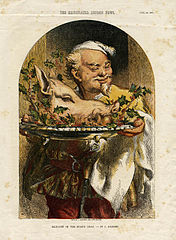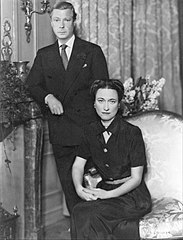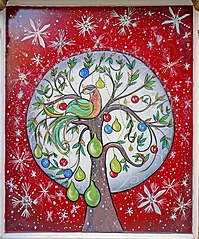
With Thanksgiving behind us, we are on the cusp of Christmas Carol season. Retailers started playing the melodies weeks ago, but soon there will be a full roster of community, church, and school programs featuring traditional carols.
On the left, is a sedate picture of a mother and her daughters singing in the dignified repose of a Victorian Christmas. But before Victorians sanitized Christmas, carols had more raucous roots . So, let’s check out a little history and see what we can find.

Carol is the name of a circle dance where everyone linked hands and sang, from the old French Carole. The tune we use for Ding Dong Merrily on High, an enthusiastically cheerful song, was originally a 16th century French dance in which the men scooped up their dance partners.
Boar’s Head Carol

One of the oldest printed carols is the 16th century Boar’s Head Carol traditionally sung at Queen’s College, Oxford, on Christmas Day as servers carry a boar’s head into the feast. No idea what the side dishes are. The song praises the tradition of sacrificing a boar and presenting its head for the Yule feast. In Norse tradition, the sacrifice was to the Goddess Freya for her favor in the new year. The boar was symbol of fertility and strength often depicted on Anglo Saxon helmets to protect the warrior.
At the feast, servers carry the head into the banquet hall on a gold or silver dish with an apple in its mouth.
The boar’s head in hand I bring
Bedecked with bays and rosemary
And I pray you, my masters, be merry
As many are at the feast.
🐗 🐗 🐗
The Boars head, as I understand,
Is the rarest dish in all this land,
Which thus bedecked with gay garland
Let us Serve with a song
🐗 🐗 🐗
Our steward hath provided this
In honor of the King of Bliss;
Which on this day to be served is
In the hall of The Queens College
Hark! The Herald Angels Sing
Before looking further into the song, allow me to reveal that as a child I thought the word were, “Hark the Herald,” Angels sing. Of course, that’s not true. The Herald Angels were singing the word “Hark!” Although, people who claim to know the truth of such things point out that Herald Angels do not travel in groups.

Anyway. Charles Wesley was walking to church one morning when he heard church bells and felt inspired to record his experience. Wesley called his poem “Hark How All the Welkin Rings.” Welkin means sky.
Wesley wrote:
Hark how all the welkin rings
Glory to the King of Kings
Peace on earth and mercy mild
God and sinners reconciled.
For twenty years, those were the words. Then along came George Whitefield, an 18th century revivalist preacher, who rewrote the poem with words we know today.
Hark! The Herald Angels Sing
Glory to the newborn King
Peace on Earth and Mercy Mild
God and sinners reconciled.
Wesley was not amused and did not want to be accountable for the “doggerel of other men.” Nevertheless, the words are attributed to Wesley.

If Wesley disliked Whitefield’s lyrics, he would have been more upset to a 1936 modification. After King Edward abdicated his throne in order to marry American divorcee Wallis Simpson, some wags sang
Hark! The Herald Angels Sing
Mrs Simpson’s pinched our king
The tune is a different matter entirely. I don’t know what the first melody was, but Felix Mendelssohn wrote the one we sing today in 1840 on the four hundredth anniversary of Gutenberg’s invention of the printing press. Mendelssohn knew the melody would probably be used for something else, and wrote he didn’t mind any lyrics, provided they weren’t religious. Apparently, the Herald Angels didn’t see Mendelssohn’s note.
How did the Partridge arrive in the Pear Tree?

One of the longest Christmas songs is “The Twelve Days of Christmas,” which first appeared in 1780 as a chant. It was probably a memory game. Each player recited the items named by the previous player and added one more.
Of all the various items, the partridge is the most awkward because English partridges live in fields and on moors. They don’t live in trees. However, a French partridge, une perdrix, is a different bird. And, if one isn’t listening too closely, une perdrix, might be mistaken for “pear tree.” This is as plausible as any other explanation.
The other items seem more straightforward . . . or not.
Contemporary pricing for the items begins with $222.68 for the partridge. There are two turtle doves [$450] ; 3 French hens [$255]; four calling birds [$600]; five gold rings, a term that refers to ring-necked pheasants [$895]; six geese [$660]; seven swans, [$13,125]; 8 milkmaids [$58]; 9 dancing ladies [$7,552.84]; 10 leaping lords, [$11,260]; 11 pipers – possibly playing the dance music [$2,943.93]; and 12 drummers [$3,183.17] to complement the pipers.
In 2021 the PNC Wealth Management Price Index estimated the total cost would be $41,205.58.
Let me just note that the milk maids deserve a raise.
🐗 🐗 🐗
Illustrations
Mother Plays Guitar While Children Sing
Dancing Circle by Franz Stuck, 1910.
Boar’s Head on a Platter, 1855.
Angels Announce Birth of Christ by Govert Flinck, 1639.
Duke & Duchess of Windsor, 1934.
Partridge in Pear Tree Window Art by Jenny Tribillon. Photo by Tim Green.
Mark Forsyth. “The Surprising Origins of Famous Christmas Carols.” BBC Culture. Dec. 19, 2016.
Margaret Minnicks. “the Twelve Days of Christmas & Their Cost.” Holidappy. Sept. 19, 2022.

Sandra Wagner-Wright holds the doctoral degree in history and taught women’s and global history at the University of Hawai`i. Sandra travels for her research, most recently to Salem, Massachusetts, the setting of her new Salem Stories series. She also enjoys traveling for new experiences. Recent trips include Antarctica and a river cruise on the Rhine from Amsterdam to Basel.
Sandra particularly likes writing about strong women who make a difference. She lives in Hilo, Hawai`i with her family and writes a blog relating to history, travel, and the idiosyncrasies of life.

